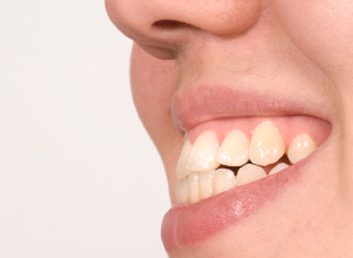
You’re using the wrong brush
What kind of brush are you using? It really does make a difference, says Dr. Ron Smith, president of the Canadian Dental Association and a dentist in Duncan, B.C. “You want a toothbrush that has relatively soft bristles and has lots of them,” he notes. Your mouth is also better off with rounded bristles, not bristles with chopped, sharp ends. If your brush isn’t right, you could be doing a poor job cleaning, and damaging your enamel while you’re at it.
While you’re giving your brush the once-over, check whether it looks worn. Toothbrushes generally last an average of three months. If your brush is looking sickly after six weeks, you could be applying too much pressure. And that can hurt your teeth. “Some patients say their teeth don’t feel clean unless they scrub hard,” says Dr. Smith. “But brushing can be a very gentle process.”

You see signs of plaque and tartar
When foods like carbs and sugars aren’t properly cleaned from your teeth, microscopic plaque germs feed on them and produce an acid, causing tooth decay and gum disease. Plaque is usually colourless. But you can buy plaque-disclosing products like tablets or rinses. These products contain a dye that will harmlessly stain your teeth in areas where plaque has been left behind.
If your teeth are covered in plaque, over time it might lead to tartar build-up, which is a hardened form of plaque and more difficult to remove. If you’re finding plaque or tartar, that’s a fairly clear indication that you need to brush up on your brushing technique.

Your gums are inflamed
Your gums can reveal when mouth isn’t being brushed properly. Do your gums bleed almost every time you brush? Are your gums red, sore or puffy? These are all signs of gingivitis or gum inflammation. It’s caused by plaque that hasn’t been brushed away.
There’s another brushing clue that can be found near the gums. Look at your teeth, both top and bottom, close to the gum line. “If you see a little notch there, that may be an indication of poor brushing,” says Dr. Smith. Enamel is thinnest close to your gums, so it may wear away here if your toothbrush is too hard or sharp, you’re scrubbing too forcefully, or you’re using an improper technique.

You’re self-concious about your smile
Are you worried that your teeth look unclean or your breath smells bad? If your pearlies aren’t pretty, it could be a sign of an underlying problem like gum disease, or simply that you need to polish your brushing technique. Check with your dentist.
The bottom line: Brush your teeth gently, not too aggressively. Don’t do the “sideways sweep,” moving your brush back and forth along the length of your mouth. Brush in small circles and focus on just one area at a time. Make sure to pay attention to cleaning along the gum line. And try to brush for a full two minutes-don’t shortchange your teeth.
Related:
• 5 things your toothbrush wants you to know
• Are you making these brushing mistakes?
• QUIZ: How much do you know about toothbrushes?
